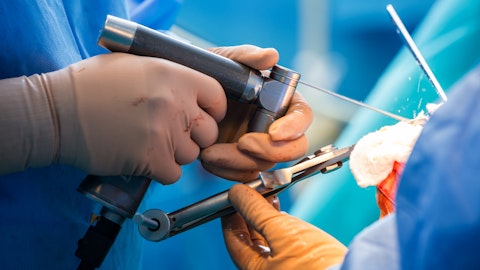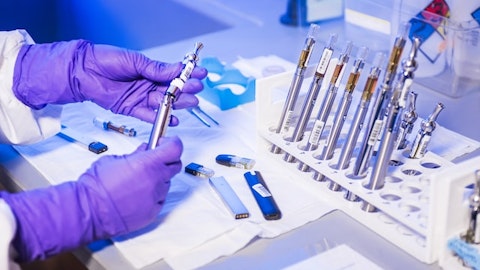Even Europe had another strong quarter. That’s just kind of expected now. It’s steady and strong growth every quarter, and we’re still not where we’d like to be in Europe. So, this is just one of those things that takes time. But if you think about something like cameras, where when we started the Transatlantic model, we were number 5 or 6, and we expect to take over number 1 sometime this year. Our power tools share was in the low 30s, and it’s crossed 50%, but it’s still not where it is in the United States. It’s not where it is in Australia. So, international should be something that continues in a very steady way. Just as it has the last five years, it’s been kind of very consistent. And in emerging markets, that’s the area we have the most opportunity, where we’re still very, very small, growing nicely, but off a small base.
Operator: We’ll take our next question from Travis Steed with Bank of America.
Travis Steed: Hey, thanks for taking the question. I’ll ask both of mine up upfront. Some of the payers and providers have talked about a slower July. I was just curious if you could kind of frame some of the summer seasonality, if you’re seeing more normal seasonality or how it kind of compares given some of those payer comments? And then a margin question for you, Glenn. Just curious if we should use the second half operating margin this year as kind of a new jumping off point since this is the more normal cost environment in the second half?
Kevin Lobo: Listen, sorry, your sound quality was a little hard hearing you. I think you’re asking about July if we saw something strange seasonality in July. And look — we don’t normally comment on one month. And I would tell you — you saw our raised guidance like we’re expecting a pretty good second half of the year. And I don’t really want to get into one month. And the — sometimes you do have certain dynamics that happen. But there’s nothing really important that I want to call out for the month of July. And then I think the second part was margin.
Glenn Boehnlein: Yes. Travis, can you repeat that in terms of the operating margin question?
Travis Steed: Yes, sorry. I’m just curious if the second half of this year is kind of the new jumping off point for margins going forward, just given that this is a more normalized cost environment in the second half?
Glenn Boehnlein: Yes. No, I would say a couple of things. First of all, Q4 is always seasonally higher. It’s our highest op margin performing quarter. So, I wouldn’t necessarily say that that should be the jumping off. I think if you back up from where our guidance is, you could sort of figure out kind of where we’re angling to end the year at, and that would be the good jumping off point.
Operator: We’ll take our next question from Danielle Antalffy with UBS.
Unidentified Analyst: This is Simon Hagan [ph] on for Danielle. Congrats on the strong quarter. Can you talk about some of the puts and takes to the underlying ortho market growth when you look at factors such as pricing, innovation and potential trend towards treating both much younger and older — much older patients? And I have one follow-up.
Kevin Lobo: Yes. Look, the trends aren’t different than what we’ve seen in the past. It’s surgery demand backlogs of surgeons that people — frankly, the older patients who’ve been — now really want to get procedures done, there are more active people out there, as I kind of referenced earlier, who want to get their procedures done. So innovation wins the day, right? So the robotics continues to be a real terrific for us, and we continue to see increased utilization. Percent of Mako procedures done continues to rise. Percent of cementless continues to rise. Percent of hips being done on Mako continues to rise. So that’s not new. Those are a continuation of prior trends. And so there isn’t some kind of new dynamic.
It’s just the pent-up demand of patients that we kept waiting for, they’re coming and they’re going to continue to come for some period of time. And the aging population, people every day, some 10,000 turn 65. And so there is demographics that are on our side. There is the hangover from COVID that’s on our side. And for Stryker, we have a portfolio that we’re really excited about. In addressing the Direct Anterior with our Insignia stem was critically important, and we’ve done that, and we’re seeing fantastic uptake of that hip stem, which is driving terrific growth in hips. So that’s kind of new for us as to — if you look in the last year, our growth has really picked up, and that was really because of the product that we launched really addressing an important and growing segment of the procedures in hips.
Unidentified Analyst: And just one follow-up, really off of what you were just talking about. Looking at the competitive position in large joints in the United States, how do you expect to continue driving share gains, and where do you see yourself given continued innovation?




